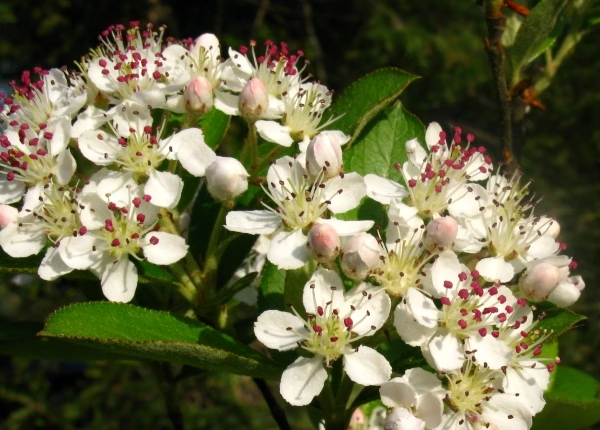
Red Chokeberry
Botanical Name
:
Aronia arbutifolia
Plant Type
:
Deciduous shrub
Seasons
:
Plant in spring or fall; blooms in late spring to early summer
Sun Level
:
Plant in spring or fall; blooms in late spring to early summer
Ideal Soil Temperature for Planting
:
65 to 75°F (18 to 24°C)
Soil Type
:
Loamy, well-draining; adaptable to wet and dry thickets
Hardiness Zones
:
3–9 (USDA)
Germination
:
3–4 weeks
P.H. Level
:
Prefers acid to neutral and alkaline (5.0–7.5)
Water/Irrigation
:
Keep newly planted well-watered until established, then only when dry
Fertilization
:
Not heavily feeding; fertilize in early spring with slow-release fertilizer if needed
Habit
:
Upright, arching branches, vase-shaped form, and multi-stemming
Propagation
:
Seed, cuttings, and division of established clumps in spring or fall
Final Plant Height
:
3–12 ft
Spread
:
2–6 ft
Flowers
:
White to light pink, 5-petaled flowers in clusters (corymbs)
Attracts
:
Bees, butterflies, and birds
Uses
:
Ornamental, erosion control, rain gardens
Companions
:
Coastal serviceberry (Amelanchier obovalis), fringe tree (Chionanthus virginicus), Virginia sweetspire (Itea virginica), cardinal flower (Lobelia cardinalis), sweet bay (Magnolia virginiana), and winterberry (Ilex verticillata)
Pruning
:
Prune old wood, thin branches, remove suckers after flowering
Toxicity
:
Generally considered non-toxic to humans and animals
Pests
:
No serious pests but round head apple borers can be a problem
Diseases
:
Some susceptibility to leaf spots and twig/fruit blight
Confused With
:
Aronia arbutifolia can be confused with Pyrus arbutifolis and Photinia pyrifolia
Botanical Name
:
Aronia arbutifolia
Plant Type
:
Deciduous shrub
Seasons
:
Plant in spring or fall; blooms in late spring to early summer
Sun Level
:
Plant in spring or fall; blooms in late spring to early summer
Ideal Soil Temperature for Planting
:
65 to 75°F (18 to 24°C)
Soil Type
:
Loamy, well-draining; adaptable to wet and dry thickets
Hardiness Zones
:
3–9 (USDA)
Germination
:
3–4 weeks
P.H. Level
:
Prefers acid to neutral and alkaline (5.0–7.5)
Water/Irrigation
:
Keep newly planted well-watered until established, then only when dry
Fertilization
:
Not heavily feeding; fertilize in early spring with slow-release fertilizer if needed
Habit
:
Upright, arching branches, vase-shaped form, and multi-stemming
Propagation
:
Seed, cuttings, and division of established clumps in spring or fall
Final Plant Height
:
3–12 ft
Spread
:
2–6 ft
Flowers
:
White to light pink, 5-petaled flowers in clusters (corymbs)
Attracts
:
Bees, butterflies, and birds
Uses
:
Ornamental, erosion control, rain gardens
Companions
:
Coastal serviceberry (Amelanchier obovalis), fringe tree (Chionanthus virginicus), Virginia sweetspire (Itea virginica), cardinal flower (Lobelia cardinalis), sweet bay (Magnolia virginiana), and winterberry (Ilex verticillata)
Pruning
:
Prune old wood, thin branches, remove suckers after flowering
Toxicity
:
Generally considered non-toxic to humans and animals
Pests
:
No serious pests but round head apple borers can be a problem
Diseases
:
Some susceptibility to leaf spots and twig/fruit blight
Confused With
:
Aronia arbutifolia can be confused with Pyrus arbutifolis and Photinia pyrifolia
Written by Nondiah Khalayi – https://www.linkedin.com/in/nondiah-khalayi/

